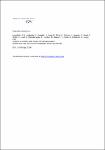Anthrax in Western and Central African Great Apes
Leendertz, Fabian
Lankester, Felix
Guislain, Patrick
Néel, Cécile
Drori, Ofir
Dupain, Jef
Speede, Sheri
Reed, Patricia
Wolfe, Nathan D.
Loul, Severin
Mpoudi-Ngole, E.
Peeters, Martine
Boesch, Christophe
Pauli, Georg
Ellerbrok, Heinz
Leroy, Eric M.
During the period of December 2004 to January 2005, Bacillus anthracis killed three wild chimpanzees (Pan troglodytes troglodytes) and one gorilla (Gorilla gorilla gorilla) in a tropical forest in Cameroon. While this is the second anthrax outbreak in wild chimpanzees, this is the first case of anthrax in gorillas ever reported. The number of great apes in Central Africa is dramatically declining and the populations are seriously threatened by diseases, mainly Ebola. Nevertheless, a considerable number of deaths cannot be attributed to Ebola virus and remained unexplained. Our results show that diseases other than Ebola may also threaten wild great apes, and indicate that the role of anthrax in great ape mortality may have been underestimated. These results suggest that risk identification, assessment, and management for the survival of the last great apes should be performed with an open mind, since various pathogens with distinct characteristics in epidemiology and pathogenicity may impact the populations. An animal mortality monitoring network covering the entire African tropical forest, with the dual aims of preventing both great ape extinction and human disease outbreaks, will create necessary baseline data for such risk assessments and management plans.
Files in this item
No license information

